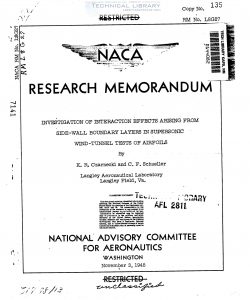naca-rm-l8g27
- Version
- 76 Downloads
- 978.12 KB File Size
- 1 File Count
- April 26, 2017 Create Date
- April 26, 2017 Last Updated
National Advisory Committee for Aeronautics, Research Memorandum - Investigation of Interaction Effects Arising from Side-Wall Boundary Layers in Supersonic Wind Tunnel Tests of Ailerons

An investigation has been made to determine the cause for a
discrepancy between theoretical and experimental pressure distributions
found. during a two—dimensional investigation'of flapped air-foils in
a 2— by 8—inch supersonic tunnel. IJ'ihe results of the investigation ,
indicated a. ‘tunnelr-boundary—layer and model—flow interaction effect on
the flow over models mounted directly from the walls in supersonic
wind tunnels. lZlIhe interaction effects or disturbances were found to
extend a considerable distance frcm. the tunnel wall, particularly on
surfaces where the Mach number approached unity. In general, strong
disturbances propagated from the boundary layer in the wing—tunnel—
wall Juncture along a wave inclined at an angle slightly greater than
the Mach angle -for the local stream. An observation indicates that
similar disturbances may arise from wing—fuselage Junctures on
supersonic airplanes.
During an investigation of the aerodynamic characteristics of
a two—dimensional flapped airfoil in a 2- by 8—inch supersonic tunnel
a large discrepancy between theoretical and experimental pressure
distributions was found. In order to determine the cause for this
disagreement, total— and static—pressure surveys were made in the test
nozzle in the vicinity of the model location both with the model
installed and with the Jet empty.
Wind tunnels.— A 2— by 8-inch supersonic tunnel in which the tests
were made is a closed—return type powered by two centrifugal blowers. The
moisture content of the tunnel air stream can be controlled over a moderate
range by bleeding dry air into the tunnel system ahead of the blowers and
bleeding air out Just ahead of the tunnel entrance section- During a test
the amount of dry air bled in and mixed air bled out was adjusted to obtain
the desired moisture content in the air stream-_ All data presented in this
paper were obtained with the quantity of the water vapor in the tunnel
air stream kept to values sufficiently low so that the effects of
condensation in the supersonic nozzle were negligible. The Mach number
in the test section was about 1.68.
| File | Action |
|---|---|
| naca-rm-l8g27 Investigation of Interaction Effects Arising from Side-Wall Boundary Layers in Supersonic Wind Tunnel Tests of Ailerons.pdf | Download |

Comment On This Post